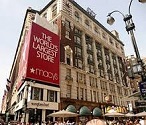
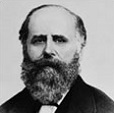



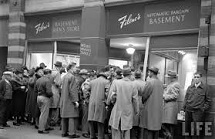
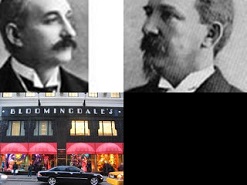

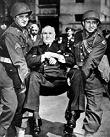









TLW's Department Storescope™ (Department Store Historyscope) |
By T.L. Winslow (TLW), the Historyscoper™ |
© Copyright by T.L. Winslow. All Rights Reserved. |
Original Pub. Date: Feb. 3, 2016. Last Update: May 3, 2017. |





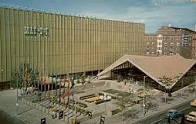
Westerners are not only known as history ignoramuses, but double dumbass history ignoramuses when it comes to department store history. Since I'm the one-and-only Historyscoper (tm), let me quickly bring you up to speed before you dive into my Master Historyscope.
The New Kid on the Black, er, Block United States of America came on the scene in the 19th cent. with the greatest mass consumer market so far in history. If you didn't at least try to set up a department store chain you were nuts :)
In 1707 Fortnum & Mason is founded in Piccadilly, London by William Fortnum and Hugh Mason as a grocery store to make and sell jams, teas and sauces, going on to become a favorite of Queen Victoria, whom they supply annually with Christmas puddings, causing them to adopt the motto "Food Fit for a Queen" before evolving into a dept. store that stocks exotic items.


On Oct. 28, 1858 R.H. Macy & Co. on 6th Ave. between 13th and 14th Sts. in New York City (far N of other dry goods stores) is founded by failed retail dry goods store owner Rowland Hussey Macy Sr. (1822-77), doing $11.08 sales the first day; the logo features a star based on a tattoo that Macy got as a teen sailor on the Nantucket whaling ship Emily Morgan; in 1902 it moves to Herald Square at 34th St. and Broadway even more N of the other dry goods stores, running a steam wagonette to transport customers, expanding to take over the entire block bounded by 7th Ave., Broadway, 34th St., and 35th St., becoming the world's largest store; on Nov. 24, 1927 the first Macy's Thanksgiving Day Parade is held; on Dec. 19, 1994 it merges with Federated Department Stores; in the 1920s it begins expanding throughout the New York City area, moving into other states in 1983; on Feb. 28, 2005 it buys May Department Stores Co. for $11B.

In 1861 Bloomingdale's luxury department store at 938 3rd Ave. in Lower East Side Manhattan, N.Y. is founded by brothers and Lyman Gustave Bloomingdale (1841-1905) and Joseph Bernard Bloomingdale (1842-1904) (sons of a Bavarian German Jewish immigrant), starting out by selling hoop skirts and European fashions before urban improvements incl. Central Park, the New York Subway, the Metropolitan Museum of Art (MoMA), and St. Patrick's Cathedral bring in wealthy clientele; in 1886 they move to 59th St. and Lexington Ave., displaying a couple of products in a big plate glass window in a theatrical fashion instead of a clutter of cr, er, merchandise.

The beginning of 50 years of the Golden Rule in American retail? In 1861 John Wanamaker (1838-1922) opens a menswear shop in Philly with his brother-in-law Nathan Brown, offering items at fixed no-haggle prices (the first price tags), growing to the #1 U.S. menswear retailer in the U.S. by 1875, when he turns an abandoned railroad depot into the Grand Depot, a "new kind of store", named after himself, becoming the first department store, going on to pioneer pneumatic tubes, escalators, employee training, and paid summer vacations, regular sales, full-page illustrated newspaper ads, in-store restaurants, reading and restrooms, and home delivery, proclaiming the "golden rule" that "the customer is always right"; in 1896 he expands to New York City, keeping ahead of Macy's in New York City, Marshall Field's in Chicago, and Filene's in Boston - in a hurry and don't wanamaker deal, shop here?

On Jan. 4, 1865 Conway, Mass.-born Marshall Field (1834-1906), gen. mgr. of Cooley & Wadsworth in Chicago, Ill. buys into the retail store of aging Potter Palmer (1826-1902), and forms a 3-way partnership with rich Jew (descended from the Bavarian house of Leiter) Levi Zeigler Leiter (1834-1904), going on to found Marshal Field & Co. in Jan. 1881 and zoom to the top; on Aug. 30, 2005 it is acquired by Macy's.


In Aug. 1872 after getting the mail order bug, Chatham, N.J.-born former traveling salesman Aaron Montgomery Ward (1844-1913) and two others form Mongomery Ward & Co. with $1.6K in capital, mailing commercial catalogs that fascinate hicks and make good butt wipe in the outhouse, introducing the money-back guarantee in 1875, opening their first store in 1926, and growing to 530 stores by 1929 (#1), down to 75% the size of rival Sears, Roebuck & Co. by 1940; too bad, his successor (1937-55) Sewell Avery (1874-1960) (known for his virulent opposition to the New Deal) refuses to expand, preferring to bank his money, and opens no stores from 1937-55, leaving it only 25% the size of Sears.

In 1877 May Department Stores Co. is founded in Leadville, Colo. by David May, booming during the Colo. Silver Rush and moving to Denver, Colo. in 1889, followed by St. Louis, Mo. in 1905; in 1956 it acquires the Daniels & Fisher Co. of Denver, Colo., merging it with the local May stores to create the May D&F division; in 2004 it takes over the Marshall Field's chain; in 2005 it is acquired by Federated Dept. Stores for $11B; in 2006 400+ former May stores are consolidated and renamed Macy's.

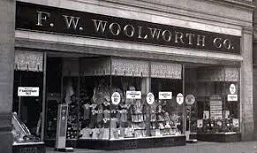
On Feb. 22, 1878 Rodman, N.Y.-born Frank Winfield "F.W." Woolworth (1852-1919) opens his first five-cent store in Utica, N.Y.; it folds, and in June he opens another in Lancaster, Penn. which prospers, then on July 18, 1979 he changes it to a five-and-dime store, expands nationwide and worldwide, and incorporates as F.W. Woolworth Co. in 1912, with 496 stores in the U.S. and Canada and a market capitalization of $30M; on Nov. 11, 1911 ground is broken for the F.W. Wooloworth Bldg., tallest bldg. in the world (finished 1913); too bad, its lunch counters are segregated in 1960?; the co. goes defunct in July 1997.


In 1881 Filene's Department Store (originally Filene's Sons and Co.) in Boston, Mass. is founded by German Jewish immigrant William Filene (1830-1901) from Posen, Prussia to sell clothing; in 1891 his sons Edward Albert Filene (1860-1937) and Abraham Lincoln Filene (1865-1957) take over mgt., using the scientific mgt. ideas of Frederick Winslow Taylor (1856-1915), opening Filene's Basement (Automatic Bargain Annex) in 1908 to go with an automatic mark-down schedule for merchandise and money-back guarantee, founding the first employee's credit union; in 1912 the flagship store at the corner of Washington and Summer Sts. in Chicago, Ill. is built by architect Daniel Burnham (his last major project), expanding to the whole block by 1929; in 1929 Filene's, Lazarus, and Abraham & Straus found Federated Department Stores in Columbus, Ohio as a holding co.


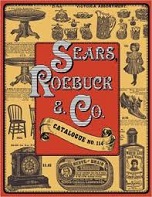
On Apr. 3, 1887 Stewartville, Minn.-born railroad station agent Richard Warren Sears (1863-1914) of North Redwood, Minn., who began buying pocket watches from a Chicago, Ill. jeweler to resell by mail last year before moving to Chicago, Ill. and placing an ad hires Lafayette, Ind.-born watchmaker Alvah Curtis Roebuck (1864-1948), and pub. his first mail-order catalog in 1888; in 1893 they incorporate Sears, Roebuck and Co., becoming one of the top U.S. retailers, opening its first retail store in Chicago in 1925 after Roebuck gets Sears to buy him out in 1895 for $20K, and goes on to become pres. of Emerson Typewriter Co. in 1909-24; in fall 1913 the Kenmore brand name is first used on sewing machines, expanding to washing machines in 1927, vacuum cleaners in 1932, ranges in 1946, dishwashers in 1951, washer-dryer combos in 1957, microwave ovens in 1971, and continuous-cleaning ceramic cooktop ranges in 1973; Sears eliminates its mail-order catalog in 1993; after Sears becomes enormously wealthy, leaving a $25M fortune in 1914, Roebuck answers queries with "He's dead. Me, I never felt better."
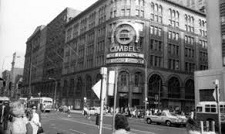
In 1887 Bavarian Jewish immigrant Adam L. Gimbel (having seven sons to support) founds Gimbels (Gimbel Brothers) department store in Vincennes, Ind., which moves to Milwaukee, Wisc. and becomes #1, expanding to Philly in 1894, and New York City in 1910, becoming the rival of Macy's, whose store is across the street in Herald Square, Manhattan, with the motto: "Select, don't settle", causing the saying "Would Macy's tell Gimbels?"; in 1920 it founds the Gimbels Thanksgiving Day Parade in Philly, beating Macy's by four years; in 1922 it goes public, acquiring Saks 34th St. in 1923, which launches Saks Fifth Avenue (founded 1898); in 1925 it expands to Pittsburgh, Penn.


In 1899 Wilkes-Barre, Penn.-born Sebastian Spering Kresge (1867-1966) founds the first S.S. Kresge five-and-dime store in Detroit, Mich., going on to build up to 85 stores in 1912, opening the first K-Mart (Kmart) in 1962.
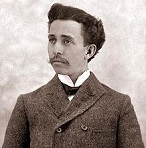

On Apr. 14, 1902 Hamilton, Mo.-born James Cash Penney (1875-1971) opens his first Golden Rule store in Kemmerer, Wyo. with $2K, moving to Salt Lake City, Utah in 1909 and growing to 34 stores in the Rocky Mt. area by 1912; in 1913 he consolidates them all under the name J.C. Penney Co., and in 1914 moves the HQ to New York City, growing to 175 stores in 22 states by 1917; in 1922 Big Mac work clothes brand is launched; in 1925 the 500th store opens in guess-where Hamilton, Mo.; in 1928 the 1,000th store opens, with the co. doing $190M/year; in 1940 Sam Walton begins working at a J.C. Penney store in Des Moines, Iowa; by 1941 there are 1.6K stores in 48 states; in 1959 the chain issues its own credit cards; in 1961 the first full-line shopping center department store is opened in Black Horse Pike Center in Audubon, N.J., followed in 1962 by King of Prussia Plaza in Penn.; in 1962 stores open in Anchorage and Fairbanks, Alaska, followed in 1966 by Honolulu, Hawaii, and San Juan, Puerto Rico in 1968 (261.5K sq. ft.); in 1962-81 it acquires the Gen. Merchandise Co., which runs discount The Treasury stores; in1971 a 300K sq. ft. store is opened in Woodfield Mall in Chicago, Ill., becoming the largest until one opens in 1998 at Plaza Las Americas in San Juan, Puerto Rico (350K sq. ft.); Old Man Cash dies on Feb. 12, 1971, and the stores all close for half a day, with revenues of $5B for the year, first time the catalog biz makes a profit; in 1973 the chain peaks at 2,053 stores incl. 300 full-line stores; in 1990 it moves to a new HQ in Plano, Tex., becoming the largest U.S. catalog retailer in 1993 after Sears closes its catalog biz; in 1996 it acquires Fay's Drug, Kerr Drug, and the Eckerd chain (sold 2004); in 1998 it launches an Internet store; in 2007 it launches the Ambrielle lingerie brand and Sephora brand cosmetics.

On Nov. 25, 1929 Federated Dept. Stores is founded in Columbus, Ohio by Fred R. Lazarus Jr. (1884-1973) via a merger with Abraham & Straus of Brooklyn, N.Y., Filene's of Boston, Mass., and Bloomingdale's of New York City, which turns into Macy's Inc. becoming the largest dept. store in the U.S., with innovations such as "pay when you can", and arranging merchandise by size, talking Pres. FDR in 1941 into having Congress change Thanksgiving from the last Thur. to the 4th Thur. in Nov. to extend the Xmas shopping season, creating Black Fri.
In 1948 E.J. Korvette (Korvettes) (Eight Jewish Korean War Vets?) is founded in New York City by WWI vet Eugene Ferkauf and his friend Joe Zwillenberg, becoming the first suburban discount store in the U.S., followed by Brant's, Grant's, King's, Topp's, etc., as more and more families get automobiles, triggering inner-city blight as Main Street merchants go under; Korvettes goes bankrupt in 1980.





The Year that K-Mart Sucks is born, along with Target and Wal-Mart? On Mar. 1, 1962 the first K-Mart (Kmart) opens in Garden City (near Detroit), Mich., run by 63-y.-o. 5-and-10-cent store chain magnate Sebastian Spering "S.S" Kresge (1867-1966), becoming #2 in sales after Sears in 1977, then getting passed up by Wal-Mart in the 1980s; meanwhile on May 1 Dayton Hudson Corp. opens the first Target discount store in Roseville (near St. Paul), Minn., growing to 1K stores in 47 states by the end of the cent. and passing K-Mart also; meanwhile on July 2 Wal-Mart (Walmart), the first discount retailer is founded in Rogers, Ark. by Okla.-born former Ben Franklin store owner Samuel Moore "Sam" Walton (1918-92), incorporating as Wal-Mart Stores Inc. on Oct. 31, 1969, and growing into the biggest mega-corp. in history (4K stores in the U.S., 1.6M employees), putting ma-and-pop stores out of biz with a super-efficient mass-merchandising machine in every 1-horse town in the U.S. obsessed with offering the lowest price in town every day on almost every item and underpaying employees, which are called associates to avoid labor laws, while the penny-pinching founder lives like an avg. joe, driving himself to pick up fast food, and giving his kids paltry allowances, even putting a slot machine in the attic to try and win it back?